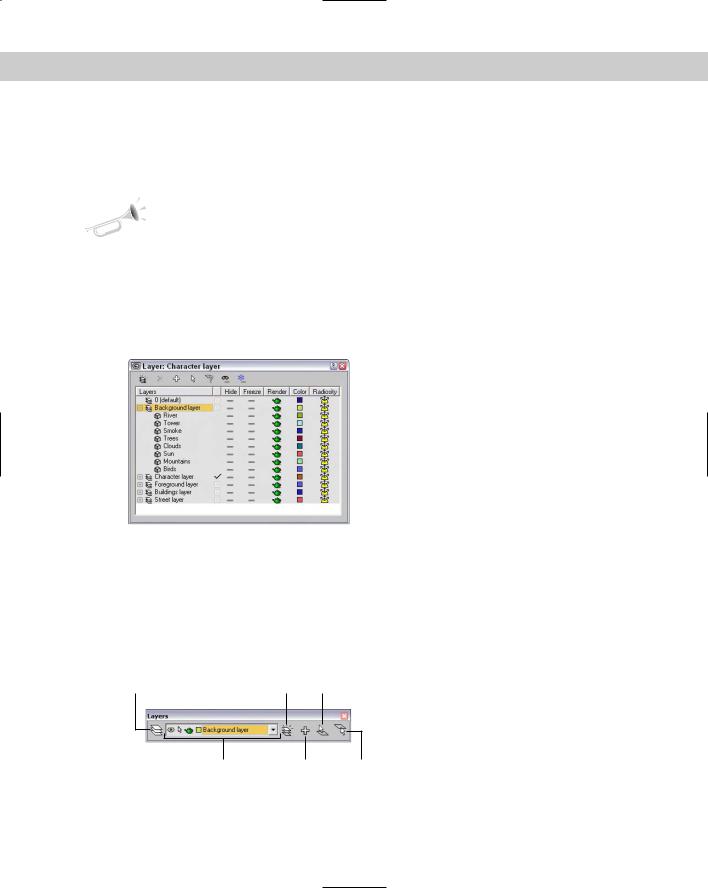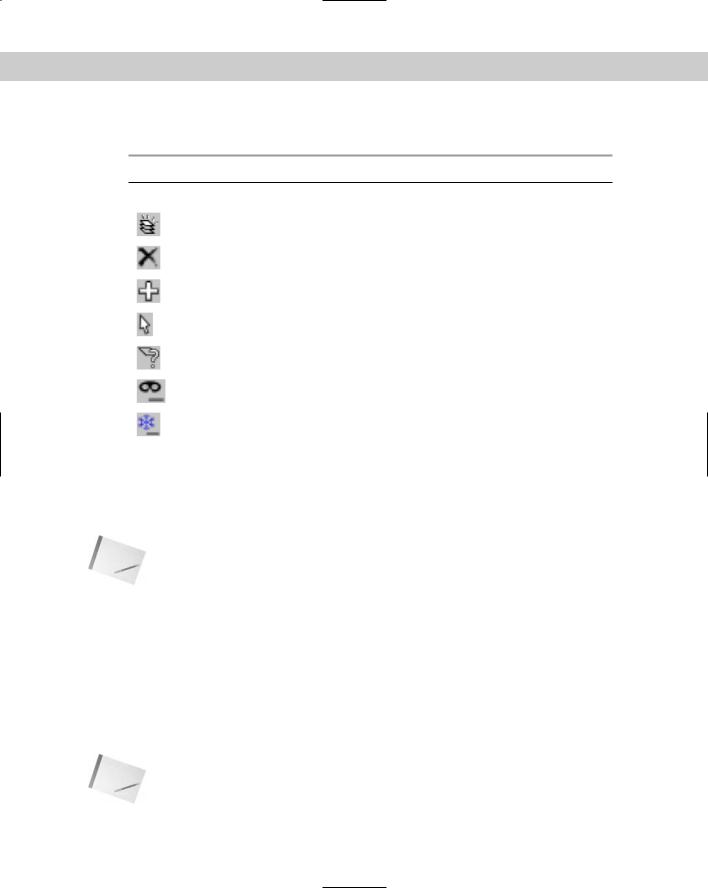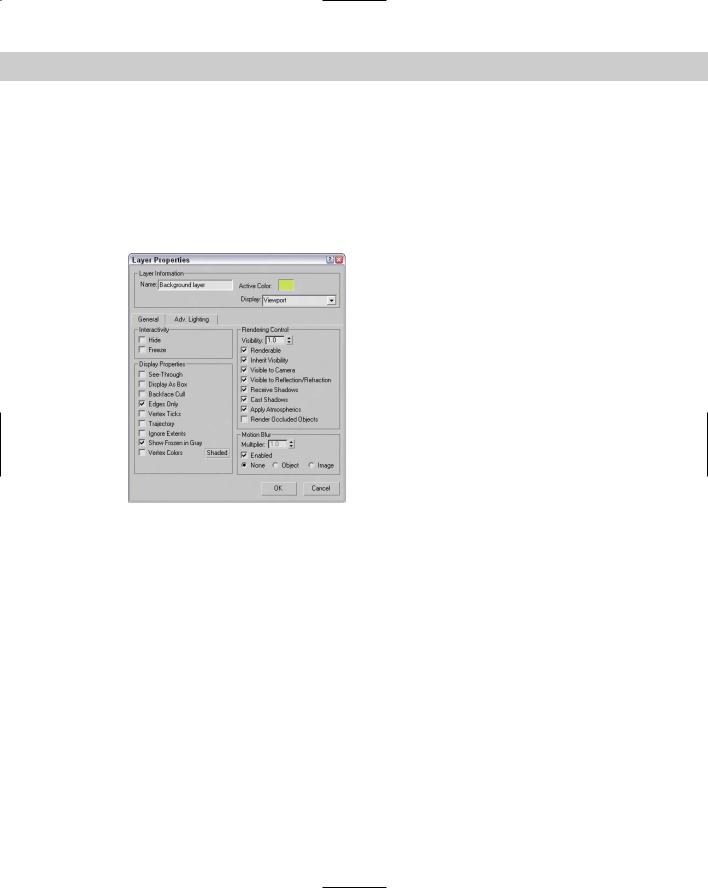
- •Preface
- •About This Book
- •Acknowledgments
- •Contents at a Glance
- •Contents
- •Relaxing at the Beach
- •Dressing the Scene
- •Animating Motion
- •Rendering the Final Animation
- •Summary
- •The Interface Elements
- •Using the Menus
- •Using the Toolbars
- •Using the Viewports
- •Using the Command Panel
- •Using the Lower Interface Bar Controls
- •Interacting with the Interface
- •Getting Help
- •Summary
- •Understanding 3D Space
- •Using the Viewport Navigation Controls
- •Configuring the Viewports
- •Working with Viewport Backgrounds
- •Summary
- •Working with Max Scene Files
- •Setting File Preferences
- •Importing and Exporting
- •Referencing External Objects
- •Using the File Utilities
- •Accessing File Information
- •Summary
- •Customizing Modify and Utility Panel Buttons
- •Working with Custom Interfaces
- •Configuring Paths
- •Selecting System Units
- •Setting Preferences
- •Summary
- •Creating Primitive Objects
- •Exploring the Primitive Object Types
- •Summary
- •Selecting Objects
- •Setting Object Properties
- •Hiding and Freezing Objects
- •Using Layers
- •Summary
- •Cloning Objects
- •Understanding Cloning Options
- •Mirroring Objects
- •Cloning over Time
- •Spacing Cloned Objects
- •Creating Arrays of Objects
- •Summary
- •Working with Groups
- •Building Assemblies
- •Building Links between Objects
- •Displaying Links and Hierarchies
- •Working with Linked Objects
- •Summary
- •Using the Schematic View Window
- •Working with Hierarchies
- •Setting Schematic View Preferences
- •Using List Views
- •Summary
- •Working with the Transformation Tools
- •Using Pivot Points
- •Using the Align Commands
- •Using Grids
- •Using Snap Options
- •Summary
- •Exploring the Modifier Stack
- •Exploring Modifier Types
- •Summary
- •Exploring the Modeling Types
- •Working with Subobjects
- •Modeling Helpers
- •Summary
- •Drawing in 2D
- •Editing Splines
- •Using Spline Modifiers
- •Summary
- •Creating Editable Mesh and Poly Objects
- •Editing Mesh Objects
- •Editing Poly Objects
- •Using Mesh Editing Modifiers
- •Summary
- •Introducing Patch Grids
- •Editing Patches
- •Using Modifiers on Patch Objects
- •Summary
- •Creating NURBS Curves and Surfaces
- •Editing NURBS
- •Working with NURBS
- •Summary
- •Morphing Objects
- •Creating Conform Objects
- •Creating a ShapeMerge Object
- •Creating a Terrain Object
- •Using the Mesher Object
- •Working with BlobMesh Objects
- •Creating a Scatter Object
- •Creating Connect Objects
- •Modeling with Boolean Objects
- •Creating a Loft Object
- •Summary
- •Understanding the Various Particle Systems
- •Creating a Particle System
- •Using the Spray and Snow Particle Systems
- •Using the Super Spray Particle System
- •Using the Blizzard Particle System
- •Using the PArray Particle System
- •Using the PCloud Particle System
- •Using Particle System Maps
- •Controlling Particles with Particle Flow
- •Summary
- •Understanding Material Properties
- •Working with the Material Editor
- •Using the Material/Map Browser
- •Using the Material/Map Navigator
- •Summary
- •Using the Standard Material
- •Using Shading Types
- •Accessing Other Parameters
- •Using External Tools
- •Summary
- •Using Compound Materials
- •Using Raytrace Materials
- •Using the Matte/Shadow Material
- •Using the DirectX 9 Shader
- •Applying Multiple Materials
- •Material Modifiers
- •Summary
- •Understanding Maps
- •Understanding Material Map Types
- •Using the Maps Rollout
- •Using the Map Path Utility
- •Using Map Instances
- •Summary
- •Mapping Modifiers
- •Using the Unwrap UVW modifier
- •Summary
- •Working with Cameras
- •Setting Camera Parameters
- •Summary
- •Using the Camera Tracker Utility
- •Summary
- •Using Multi-Pass Cameras
- •Creating Multi-Pass Camera Effects
- •Summary
- •Understanding the Basics of Lighting
- •Getting to Know the Light Types
- •Creating and Positioning Light Objects
- •Viewing a Scene from a Light
- •Altering Light Parameters
- •Working with Photometric Lights
- •Using the Sunlight and Daylight Systems
- •Using Volume Lights
- •Summary
- •Selecting Advanced Lighting
- •Using Local Advanced Lighting Settings
- •Tutorial: Excluding objects from light tracing
- •Summary
- •Understanding Radiosity
- •Using Local and Global Advanced Lighting Settings
- •Working with Advanced Lighting Materials
- •Using Lighting Analysis
- •Summary
- •Using the Time Controls
- •Working with Keys
- •Using the Track Bar
- •Viewing and Editing Key Values
- •Using the Motion Panel
- •Using Ghosting
- •Animating Objects
- •Working with Previews
- •Wiring Parameters
- •Animation Modifiers
- •Summary
- •Understanding Controller Types
- •Assigning Controllers
- •Setting Default Controllers
- •Examining the Various Controllers
- •Summary
- •Working with Expressions in Spinners
- •Understanding the Expression Controller Interface
- •Understanding Expression Elements
- •Using Expression Controllers
- •Summary
- •Learning the Track View Interface
- •Working with Keys
- •Editing Time
- •Editing Curves
- •Filtering Tracks
- •Working with Controllers
- •Synchronizing to a Sound Track
- •Summary
- •Understanding Your Character
- •Building Bodies
- •Summary
- •Building a Bones System
- •Using the Bone Tools
- •Using the Skin Modifier
- •Summary
- •Creating Characters
- •Working with Characters
- •Using Character Animation Techniques
- •Summary
- •Forward versus Inverse Kinematics
- •Creating an Inverse Kinematics System
- •Using the Various Inverse Kinematics Methods
- •Summary
- •Creating and Binding Space Warps
- •Understanding Space Warp Types
- •Combining Particle Systems with Space Warps
- •Summary
- •Understanding Dynamics
- •Using Dynamic Objects
- •Defining Dynamic Material Properties
- •Using Dynamic Space Warps
- •Using the Dynamics Utility
- •Using the Flex Modifier
- •Summary
- •Using reactor
- •Using reactor Collections
- •Creating reactor Objects
- •Calculating and Previewing a Simulation
- •Constraining Objects
- •reactor Troubleshooting
- •Summary
- •Understanding the Max Renderers
- •Previewing with ActiveShade
- •Render Parameters
- •Rendering Preferences
- •Creating VUE Files
- •Using the Rendered Frame Window
- •Using the RAM Player
- •Reviewing the Render Types
- •Using Command-Line Rendering
- •Creating Panoramic Images
- •Getting Printer Help
- •Creating an Environment
- •Summary
- •Creating Atmospheric Effects
- •Using the Fire Effect
- •Using the Fog Effect
- •Summary
- •Using Render Elements
- •Adding Render Effects
- •Creating Lens Effects
- •Using Other Render Effects
- •Summary
- •Using Raytrace Materials
- •Using a Raytrace Map
- •Enabling mental ray
- •Summary
- •Understanding Network Rendering
- •Network Requirements
- •Setting up a Network Rendering System
- •Starting the Network Rendering System
- •Configuring the Network Manager and Servers
- •Logging Errors
- •Using the Monitor
- •Setting up Batch Rendering
- •Summary
- •Compositing with Photoshop
- •Video Editing with Premiere
- •Video Compositing with After Effects
- •Introducing Combustion
- •Using Other Compositing Solutions
- •Summary
- •Completing Post-Production with the Video Post Interface
- •Working with Sequences
- •Adding and Editing Events
- •Working with Ranges
- •Working with Lens Effects Filters
- •Summary
- •What Is MAXScript?
- •MAXScript Tools
- •Setting MAXScript Preferences
- •Types of Scripts
- •Writing Your Own MAXScripts
- •Learning the Visual MAXScript Editor Interface
- •Laying Out a Rollout
- •Summary
- •Working with Plug-Ins
- •Locating Plug-Ins
- •Summary
- •Low-Res Modeling
- •Using Channels
- •Using Vertex Colors
- •Rendering to a Texture
- •Summary
- •Max and Architecture
- •Using AEC Objects
- •Using Architectural materials
- •Summary
- •Tutorial: Creating Icy Geometry with BlobMesh
- •Tutorial: Using Caustic Photons to Create a Disco Ball
- •Summary
- •mental ray Rendering System
- •Particle Flow
- •reactor 2.0
- •Schematic View
- •BlobMesh
- •Spline and Patch Features
- •Import and Export
- •Shell Modifier
- •Vertex Paint and Channel Info
- •Architectural Primitives and Materials
- •Minor Improvements
- •Choosing an Operating System
- •Hardware Requirements
- •Installing 3ds max 6
- •Authorizing the Software
- •Setting the Display Driver
- •Updating Max
- •Moving Max to Another Computer
- •Using Keyboard Shortcuts
- •Using the Hotkey Map
- •Main Interface Shortcuts
- •Dialog Box Shortcuts
- •Miscellaneous Shortcuts
- •System Requirements
- •Using the CDs with Windows
- •What’s on the CDs
- •Troubleshooting
- •Index

208 Part II Working with Objects
Using Layers
So what does 3ds max have in common with a wedding cake? The answer is layers. Layers provide a way to separate scene objects into easy-to-select and easy-to-work-with groupings. These individual layers have properties that can then be turned on and off.
New |
The Layer Manager has been redesigned for 3ds max 6. |
Feature |
|
Using the Layer Manager
You create, access, and manage layers through the Layer Manager dialog box, shown in Figure 6-15. This dialog box is a floater that can remain open as you work with objects in the viewports. You can access the Layer Manager using the Tools Layer Manager menu command, by clicking the Layer Manager button on the main toolbar, or by clicking on the same button in the Layers toolbar.
Figure 6-15: The Layer Manager lists all the layers and the objects contained within each layer.
After you’ve set up your layers, you can control them using the Layer toolbar, shown in Figure 6-16, rather than having the Layer Manager open. You can access the Layer toolbar by right-clicking the main toolbar away from the buttons and selecting Layers toolbar from the pop-up menu or by selecting the Customize Show UI Floating Toolbars menu command.
Layer |
|
Select Objects |
Manager |
Create New Layer |
in Current Layer |
Layer Selection |
Add Selection |
Set Current Layer |
drop-down list |
to Current Layer |
to Selection's Layer |
Figure 6-16: Use the Layers toolbar to set the active layer.

Chapter 6 Selecting Objects and Setting Object Properties |
209 |
Table 6-4 lists the buttons found in the Layer Manger and in the Layers toolbar.
Table 6-4: Layer Manager Buttons
Button Icon |
Name |
Description |
|
|
|
|
Create New Layer |
Creates a new layer that includes the |
|
|
selected objects. |
|
Delete Highlighted Empty Layers |
Deletes a layer if the layer is highlighted |
|
|
and empty. |
|
Add Selected Objects to |
Adds any selected objects to the current |
|
Highlighted Layer |
highlighted layer. |
|
Select Highlighted Objects |
Selects in the viewports any highlighted |
|
and Layers |
layers or objects. |
|
Highlight Selected Object’s Layers |
Highlights the layer of the viewport’s |
|
|
selected object in the Layer Manager. |
|
Hide/Unhide All Layers |
Toggles between hiding and unhiding all |
|
|
layers. |
|
Freeze/Unfreeze All Layers |
Toggles between freezing and unfreezing |
|
|
all layers. |
|
|
|
With the Layer Manager open, you can create new layers by clicking the Create New Layer button. This adds a new layer to the manager, names it “Layer01,” and includes any selected objects as part of the layer. If you click the layer’s name, you can rename it. Layer 0 is the default layer to which all objects are added, if other layers don’t exist. Layer 0 cannot be renamed.
Note |
Although you can rename layers in the Layer Manager, you cannot use the Layer Manager to |
|
rename objects. |
Creating a new layer automatically makes the new layer the current layer as denoted by the check mark in the first column of the Layer Manager. All new objects that are created are automatically added to the current layer. Only one layer can be current at a time, but several layers or objects can be highlighted. To highlight a layer, click it in the Layer Manager. Highlighted layers are highlighted in yellow.
A highlighted layer can be deleted with the Delete Empty Layer button, but only if it is not the current layer and if it doesn’t contain any objects.
Newly created objects are added to the current layer (the one marked with a check mark in the first column of the Layer Manager). If you forget to select the correct layer for the new objects, you can select the objects in the viewports, highlight the correct layer, and use the Add Selected Objects to Highlighted Layer button to add the objects to the correct layer.
Note |
Every object can be added only to a single layer. You cannot add the same object to multiple |
|
layers. |

210 Part II Working with Objects
The Select Highlighted Objects and Layers button selects the highlighted layers (and objects) in the viewports. This provides a way to select all the objects on a given layer. If an object in the viewports is selected, you can quickly see which layer it belongs to with the Highlight Selected Object’s Layers button.
If you expand the layer name in the Layer Manager, you see a list of all the objects contained within the layer. If you click the Layer icon (to the left of the layer’s name), the Layer Properties dialog box, shown in Figure 6-17, opens. Clicking the Object icon opens the Object Properties dialog box.
Figure 6-17: The Layer Properties dialog box is similar to the Object Properties dialog box, but it applies to the entire layer.
Using the Layer List
The main section of the Layer Manager (and repeated in the Layers toolbar) is the layer lists and its columns, which allow you to turn certain properties on and off. The properties in the columns include Hide, Freeze, Render, Color, and Radiosity. If a property is enabled, a simple icon is displayed; if disabled, a dash is displayed. If an object is set to get its property from the layer (by clicking the ByLayer button in the Object Properties dialog box), then a dot icon is displayed. Individual objects within a layer can have different properties. You can sort the column properties by clicking on the column head.
You can toggle these properties on and off by clicking on them. You can also set these properties in the Layers toolbar. The Hide toggle determines whether the layer’s objects are visible in the viewports. The Freeze toggle makes objects on a layer unselectable. The Render toggle enables the layer’s objects to be rendered. The Color toggle sets the layer color. Layer 0 is set to assign random colors and cannot be changed. The Radiosity toggle includes the layer’s objects in the radiosity calculations.

Chapter 6 Selecting Objects and Setting Object Properties |
211 |
The Layer Manager also includes a right-click pop-up menu that includes many of the same commands found as buttons, but a unique set of commands found in the right-click pop-up menu are the Cut and Paste commands. With these commands, you can select objects in one layer to cut and paste into another layer.
Tutorial: Dividing a scene into layers
As a scene begins to come together, you’ll start to find that it is difficult to keep track of all the different pieces. This is where the layers interface can really help. In this example, we take a simple scene and divide it into several layers.
To divide a scene into layers, follow these steps:
1.Open the Elk on hill layers.max scene file.
You can find it in the Chap 06 directory on the CD-ROM. This file includes an Elk model created by Viewpoint Datalabs.
2.Select Tools Layer Manager to open the Layer Manager.
3.With no objects selected, click the Create New Layer button and name the layer Hill and trees. Click the Create New Layer button again, and name this layer Elk. Click the Create New Layer button again, and create a layer named Background and light. The Layer Manager now includes four layers, including layer 0.
4.In the Layer Manager, click on the first column for the Elk layer to make it the current layer. With the Edit Select All (Ctrl+A) menu command, select all objects in the scene and click the Add Selected Objects to Highlighted Layer button in the Layer Manager.
5.Expand the Elk layer by clicking the plus icon to the left of its name. This displays all the objects within this layer.
6.Select all the trees and the hill objects by holding down the Ctrl key and clicking each object’s name in the Layer Manager. Then right-click away from the names, and select Cut from the pop-up menu. Then select the Hill and trees layer, and select Paste from the right-click pop-up menu.
7.Select the background and light objects from within the Elk layer, and click the Select Highlighted Objects and Layers button. Then select the Background and light layer, and click the Add Selected Objects to Highlighted Layer button to move the background and light objects to the correct layer.
You can now switch between the layers, depending on which one you want to add objects to or work on, and you can change properties as needed. For example, to focus on the deer object, you can quickly hide the other layers using the Layer Manager. Figure 6-18 shows the various layers and the objects in each layer.
